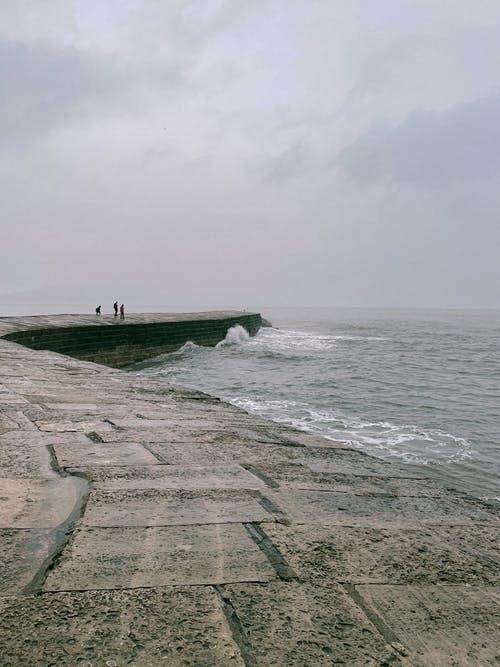I am not sensible of any Blunders about Dawlish. The Library was particularly pitiful & wretched 12 years ago, & not likely to have anybody’s publication.
Jane Austen – August 1814.
For such an enthusiastic reader as Jane Austen, this shortcoming in the library at Dawlish, a seaside town on the south coast of Devon, would have been particularly disappointing. Seaside libraries during this period often diversified and catered for an assorted clientele. They did not just stock books but would sell souvenirs, gifts and toys, and were a place where people would meet and socialise, particularly if new to the area. In Sanditon, Jane Austen’s last unfinished novel set in a fictional seaside resort, the library sells “Drawers of rings and Broches [sic]” and “all the useless things in the World that could not be done without”. A new arrival to the resort is more concerned with the list of subscribers to the Library than the stock and “could not but feel that the List was not only without Distinction, but less numerous than he had hoped.” (chapter six).
Returning to the initial remark regarding Dawlish library, Jane Austen is replying to a letter from her novel-writing niece Anna who seeks advice and guidance about her current work. This reference to Dawlish is the only indication of a visit, presumably in 1802, although as far back as November 1800 Jane refers in a letter to “the Dawlish scheme” indicating possible plans to holiday there. In a further letter two months later however, she writes that “Sidmouth is now talked of as our summer abode” indicating a possible stay there in 1801.
Today, the coastal regions of the south west look like becoming a very popular holiday venue as the challenges of a summer holiday abroad will see many taking vacations closer to home. In the opening years of the nineteenth century, the south west coast appealed to the Austen family at a time of significant upheaval. They moved to Bath in 1801 and Jane left the house in Steventon, Hampshire where she had lived nearly all her life.
Sadly, there are no surviving letters by Jane for over three years from May 1801 until September 1804. When they recommence, she is in Lyme Regis and writing to her sister Cassandra of the warm and dry weather that has continued into September allowing her to indulge accordingly: “The Bathing was so delightful this morning … that I believe I staid in rather too long, as since the middle of the day I have felt unreasonably tired.” In the same letter she writes of walking “for an hour on the Cobb” and would later draw upon its open and exposed situation for a pivotal scene in her final completed novel, Persuasion:

There was too much wind to make the high part of the new Cobb pleasant for the ladies, and they agreed to get down the steps to the lower, and all were contented to pass quietly and carefully down the steep flight, excepting Louisa; she must be jumped down them by Captain Wentworth. In all their walks, he had had to jump her from the stiles; the sensation was delightful to her. The hardness of the pavement for her feet, made him less willing upon the present occasion; he did it, however; she was safely down, and instantly, to show her enjoyment, ran up the steps to be jumped down again. He advised her against it, thought the jar too great; but no, he reasoned and talked in vain; she smiled and said, ‘I am determined I will’: he put out his hands; she was too precipitate by half a second, she fell on the pavement on the Lower Cobb, and was taken up lifeless!
(Persuasion, chapter twelve).

Despite these references, Austen’s only true seaside novel was Sanditon, abandoned unfinished after only twelve chapters in March 1817, four months before her death. It is set in a fictional fishing village on the Sussex coast and examines its’ transition from a quiet sleepy residence into a popular holiday resort, allowing Austen to exploit the comic potential: “The Sea air and Sea Bathing together were nearly infallible, one or the other of them being a match for every Disorder, of the Stomach, the Lungs or the Blood; They were anti-spasmodic, anti-pulmonary, anti-sceptic [sic], anti-bilious and anti-rheumatic.” (chapter two). Many critics believe Sanditon would have been a masterpiece.
The library is at the heart of Sanditon with many references over these opening twelve chapters including Mrs Whitby who is in there “reading one of her own Novels, for want of Employment” (chapter six). As we saw at the start of this blog, Jane Austen may not have been pleased with the ‘pitiful & wretched’ library at Dawlish, but the one she frequented in Godmersham Park, in Kent, on six occasions did not disappoint. This fine Palladium building was the home of her brother, Edward, who had been adopted by a rich childless couple and inherited great wealth and property. Jane Austen’s visits included both the year that preceded and followed her trip to Lyme Regis in 1804. Her letters show her immersion in the library. On one occasion she writes to her sister Cassandra that “we live in the Library except at Meals & have a fire every Even.” whilst another time she delights in being “alone in the library, Mistress of all I survey”. You can explore the books she had access to in the virtual library that was recently put together; for more information and to browse the books, go to www.readingwithausten.com. Although the letters indicate a contentment with the environs of Godmersham Park, some believe Jane travelled from here to Ramsgate in 1803 to visit her brother Francis, a Royal Navy officer, who was headquartered there at the time.
Jane Austen made several lengthy visits to the coast in the very early years of the nineteenth century. When her father died unexpectedly in January 1805, these lengthy holidays died with him. The Austen family continued to live in Bath and then Southampton before moving to the more favourable surrounds of Chawton cottage in 1809, Jane’s last home. Here she wrote, revised and had published all her novels, including Persuasion with its praise of Lyme Regis and the surrounding area:
… the Cobb itself, its old wonders and new improvements, with the very beautiful line of cliffs stretching out to the east of the town, are what the stranger’s eye will seek; … The scenes in its neighbourhood, Charmouth, with its high grounds and extensive sweeps of country, and still more its sweet retired bay, backed by dark cliffs, where fragments of low rock among the sands make it the happiest spot for watching the flow of the tide, for sitting in unwearied contemplation; – the woody varieties of the cheerful village of Up Lyme, and, above all, Pinny, with its green chasms between romantic rocks, where the scattered forest trees and orchards of luxuriant growth declare that many a generation must have passed away since the first partial falling of the cliff prepared the ground for such a state, where a scene so wonderful and so lovely is exhibited, as may more than equal any of the resembling scenes of the far-famed Isle of Wight : these places must be visited, and visited again, to make the worth of Lyme understood.
(Persuasion, chapter eleven).
The Austen scholar Deirdre le Faye in Jane Austen’s Country Life believed that nowhere in her novels does Jane describe scenery with such enthusiasm and passion, and I tend to agree.
Dedicated to Deirdre Le Faye
All quotations from letters taken from Jane Austen’s Letters. Fourth edition. Collected and edited by Deirdre Le Faye. Oxford: OUP, 2011.
